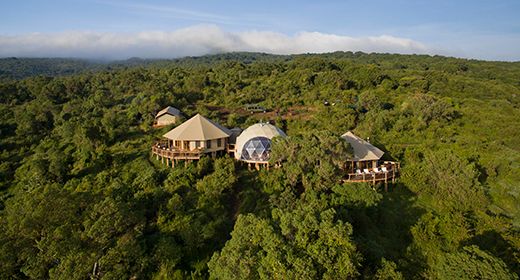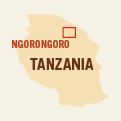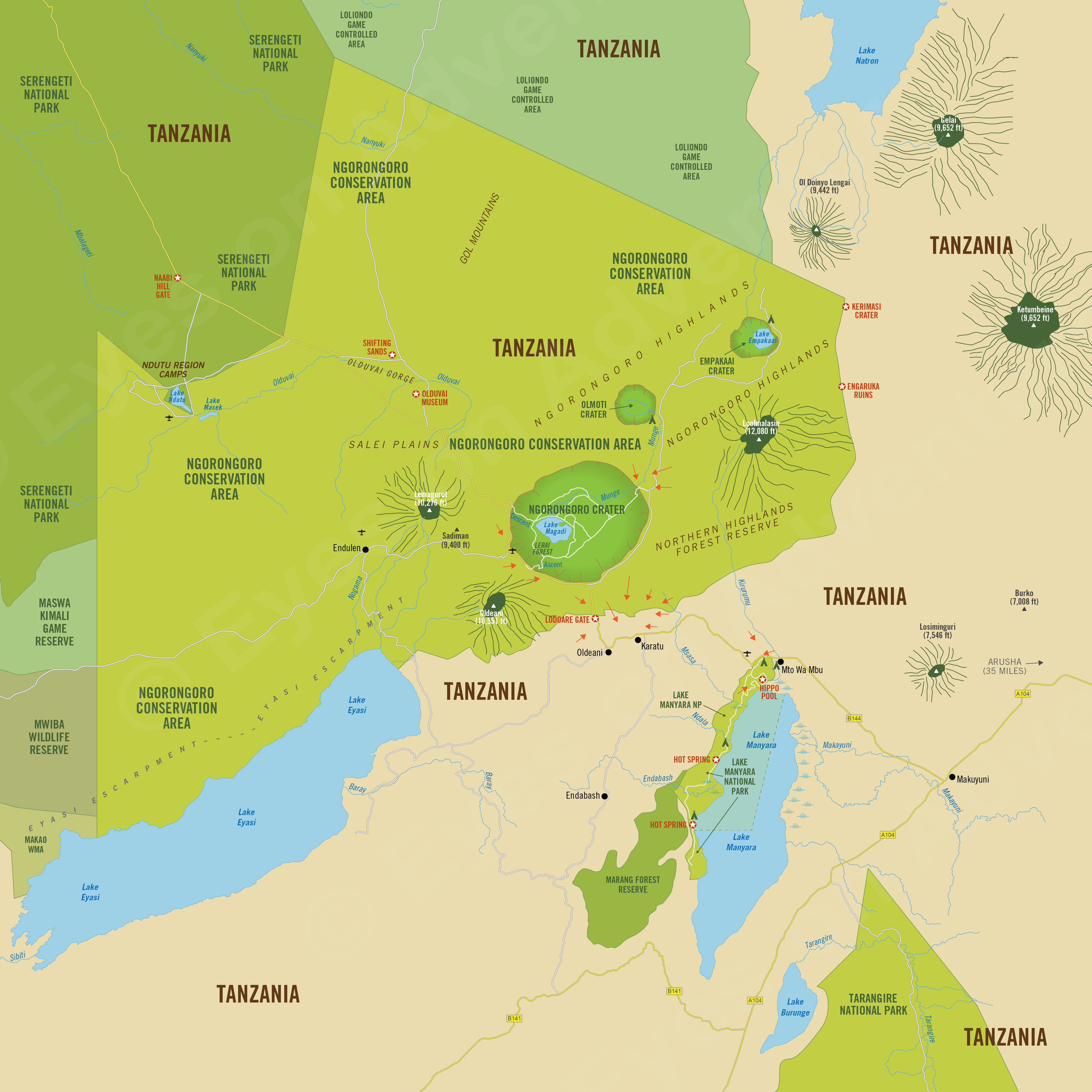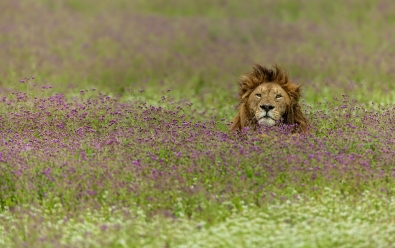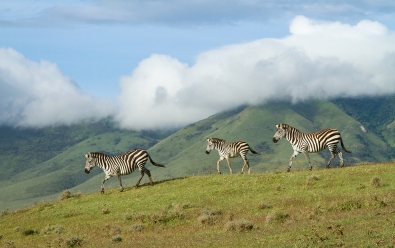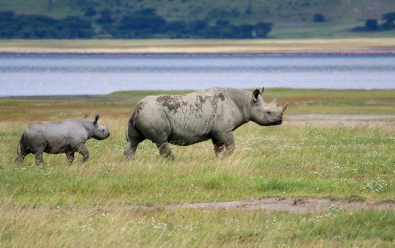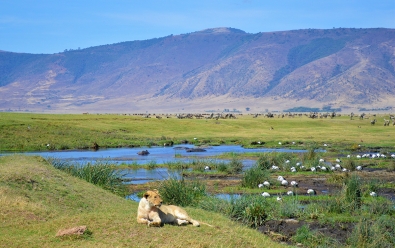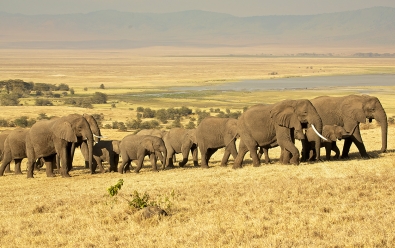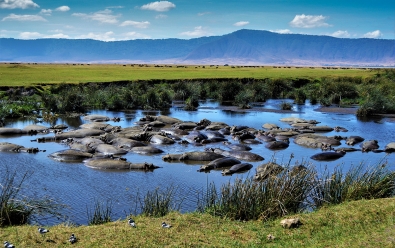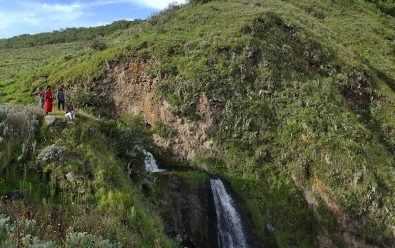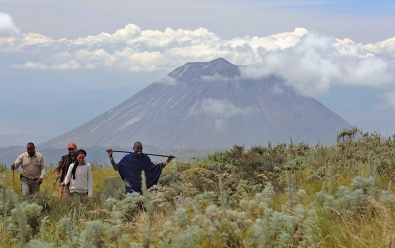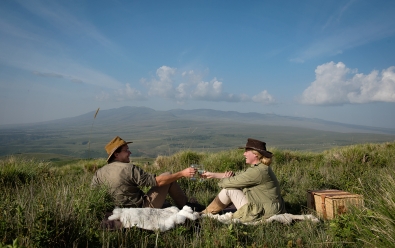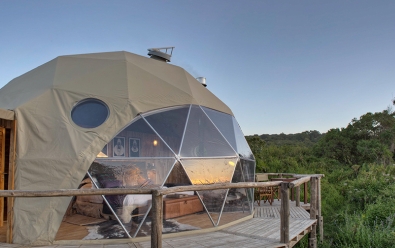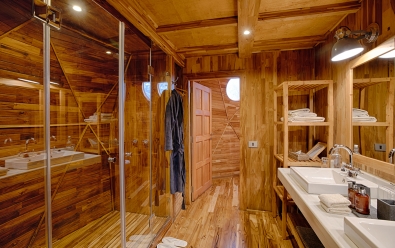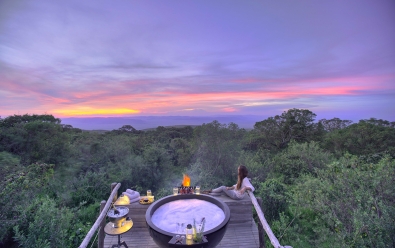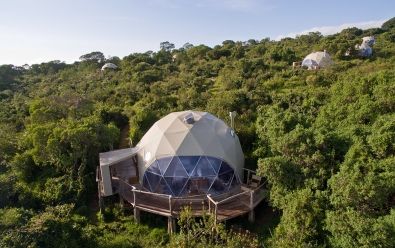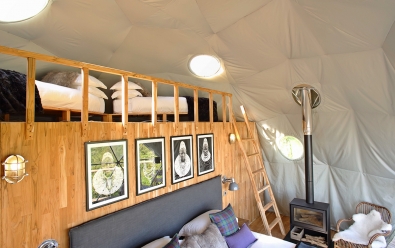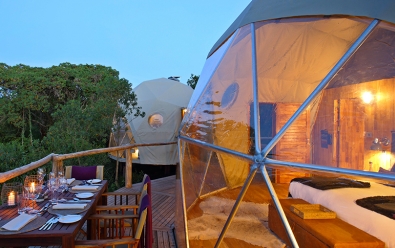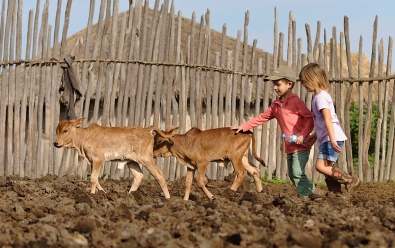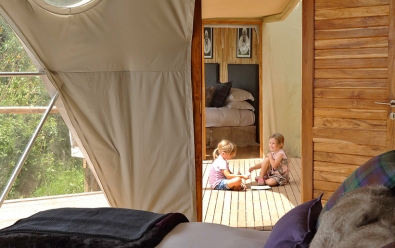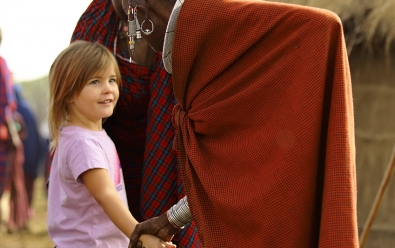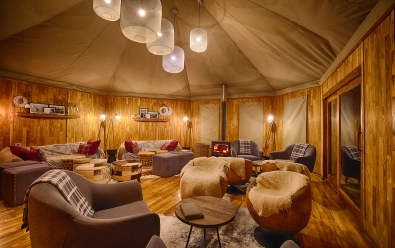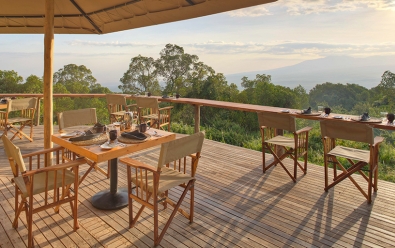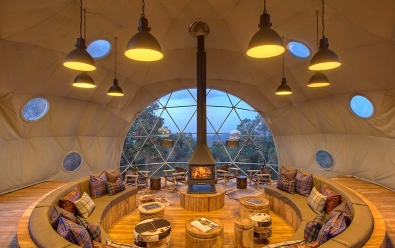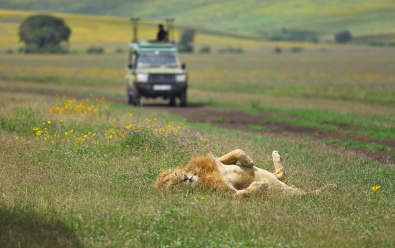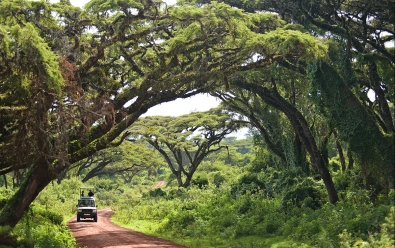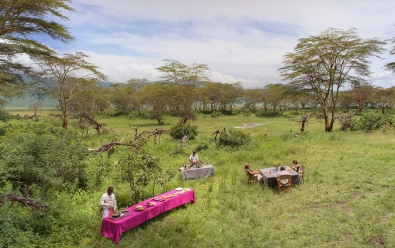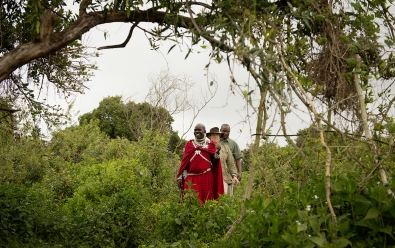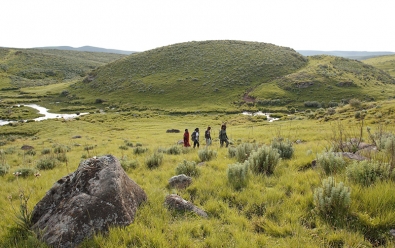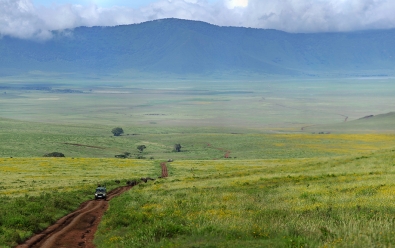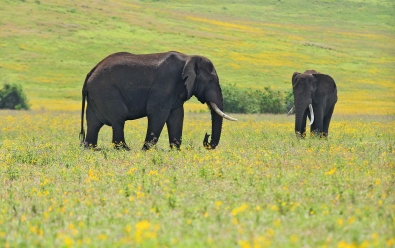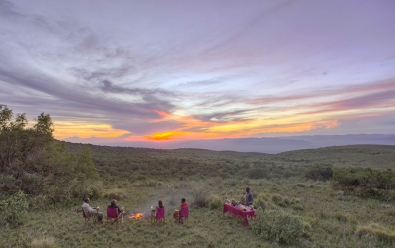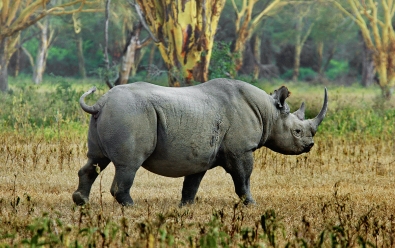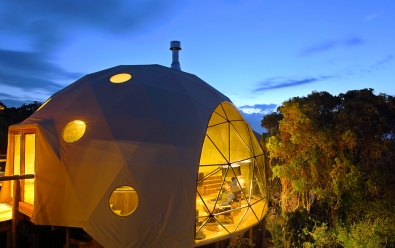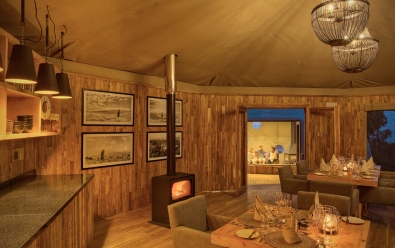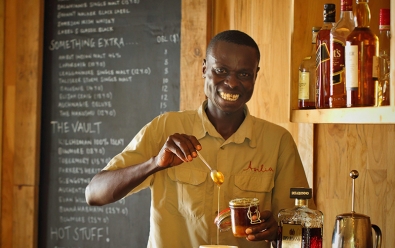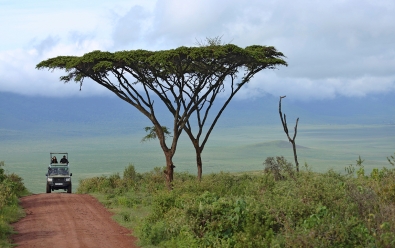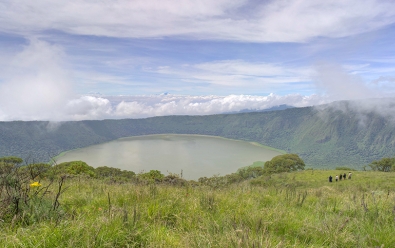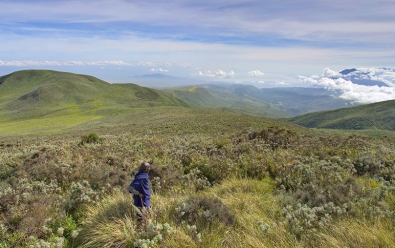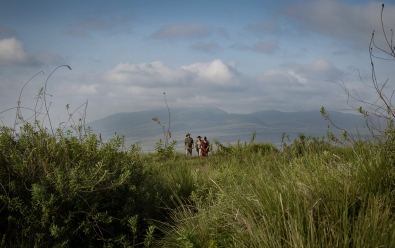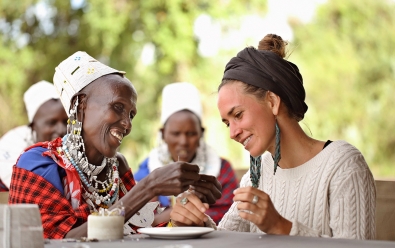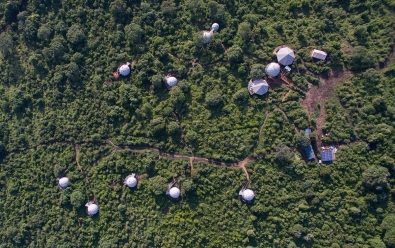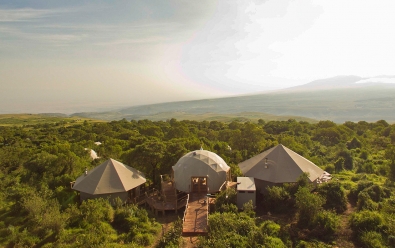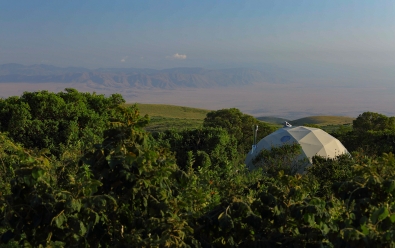The Highlands
Location
- Northern side of Olmoti Crater
- Ngorongoro Conservation Area
- Northern Tanzania
The Highlands is a contemporary lodge located within a montane forest on the northern slopes of the extinct Olmoti volcano in the lush Ngorongoro Highlands.
The lodge is set apart from the busier area to the south around the the region's main attraction, the Ngorongoro Crater, but still close enough to allow full-day game drives into the crater.
The lodge's exclusive location makes it the only accommodation that can offer half-day excursions to the remote Empakaai Crater. The Highlands is the highest-altitude accommodation in the region.
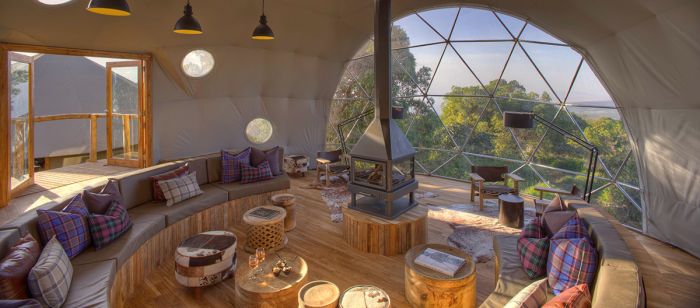
One of two lounge spaces at The Highlands Ngorongoro.
The Ngorongoro Crater is the world's largest intact, non-flooded caldera and is home the around 30 000 wild animals, including all of Africa's Big Five (lion, leopard, elephant, rhino, and buffalo). Safaris inside the crater offer guaranteed wildlife around every corner and the setting itself is like nowhere else on the continent.
Besides safaris to see the abundant wildlife in the Ngorongoro Crater, activities available at The Highlands include guided walks in the montane forest around the camp, climbing to the rim of Olmoti Crater, half-day or full-day descents into Empakaai Crater, with a picnic lunch beside the tranquil lake, and a cultural visit to one of the Maasai settlements located near the lodge.
Guests looking for some pampering can visit the on-site spa and sauna for a massage or other wellness treatment.
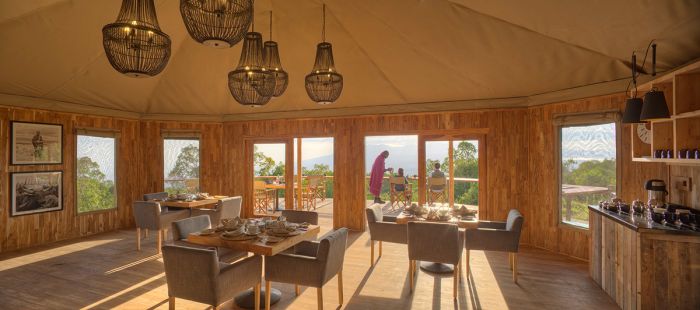
The main area dining space at The Highlands Ngorongoro.
The Highlands offers eight uniquely-designed, contemporary guest suites, including one double-suite that is designed for a family with children. Standard rooms are also available as a triple to accommodate a child. The suites are constructed in the shape of a geodesic dome, which is not dissimilar to the shape of one of the Maasai 'bomas' that are found in their settlements.
All of the suites include plumbed, en-suite facilities, a wood-burning fireplace for added comfort during the chilly montane nights, and a wrap-around balcony for views over the forest.
The lodge's main guest area includes separate spaces comprising two cozy lounges, a dining room, and a viewing deck, which is also used for dining. The Highlands Spa is just a short stroll away.
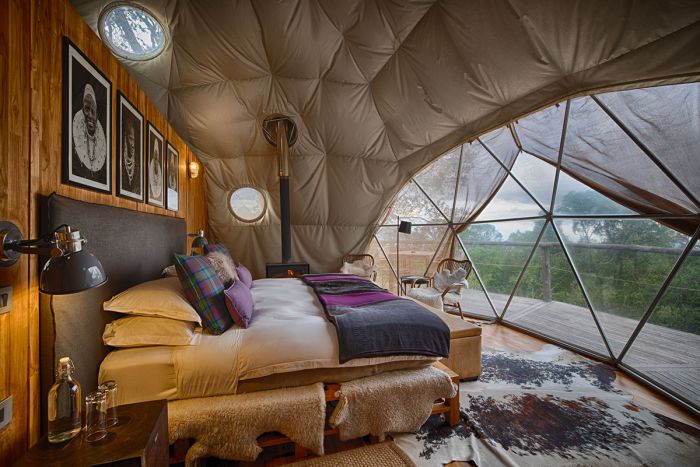
Guest suite at The Highlands Ngorongoro.
About The Ngorongoro Conservation Area
The 3 200-square-mile (8 300-sq-km) Ngorongoro Conservation Area (NCA) is a UNESCO Biosphere Reserve (declared in 1981) and is one of Africa's most diverse regions. The NCA protects an extremely rich and diverse ecosystem that includes the volcanic highlands situated between Africa's Great Rift Valley to the east and the Serengeti Plains to the west.
The Ngorongoro Crater is the highlight of the region, but there are numerous other volcanos and calderas, plus forests, plains, rivers, lakes, and fertile valleys.
The volcanic southeast portion of the NCA consists of a line of eight, mostly extinct, shield volcanos along the Gregory Rift Escarpment. Five of these volcanos are dome-shaped cones and three are calderas (collapsed volcanos). The Ngorongoro Crater is the largest of the calderas and is one of Africa's greatest eco-tourism destinations, with thousands of large mammals living in the crater.
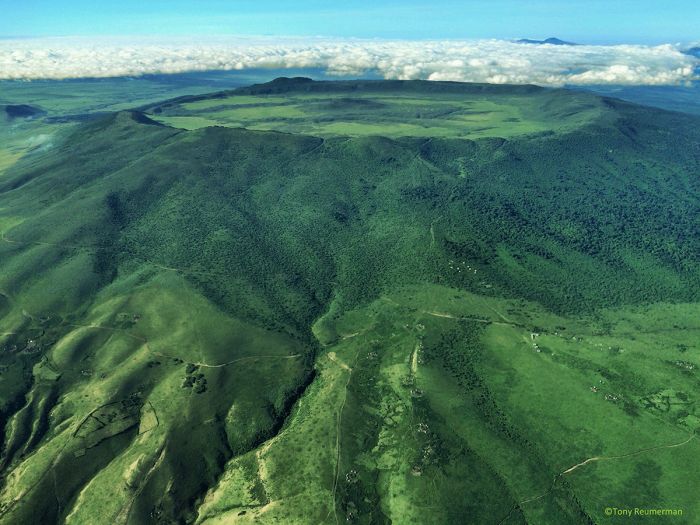
Aerial view of Olmoti volcano and crater.
The northwest portion of the NCA adjoins with Serengeti National Park and consists of open grasslands and plains and the Gol Mountains (consisting of inselbergs). To the west of the Ngorongoro Highlands, towards the Serengeti, lies Olduvai Gorge, one of the most important paleo-anthropological sites on Earth, where Mary and Louis Leakey made discoveries about the earliest hominins. The nearby Salei Plains are a hotspot for the annual Great Migration of wildebeest and zebra, which move through the NCA between December and April.
The far western part of NCA includes the Lake Ndutu Area, which is a very popular destination in the southern Serengeti plains, especially when the migration of wildebeests and zebras are present in huge numbers between December and April. Some of the camps around Ndutu are located in the Serengeti National Park while others are in the NCA.
Ngorongoro is Tanzania's most visited wildlife area, attracting some 300 000 tourists from around the world each year and it is one of Africa's must-see destinations. Many safari itineraries begin in Arusha town to the east, driving west towards the Serengeti and stopping to visit Ngorongoro (and sometimes Lake Manyara) for a few days along the way.
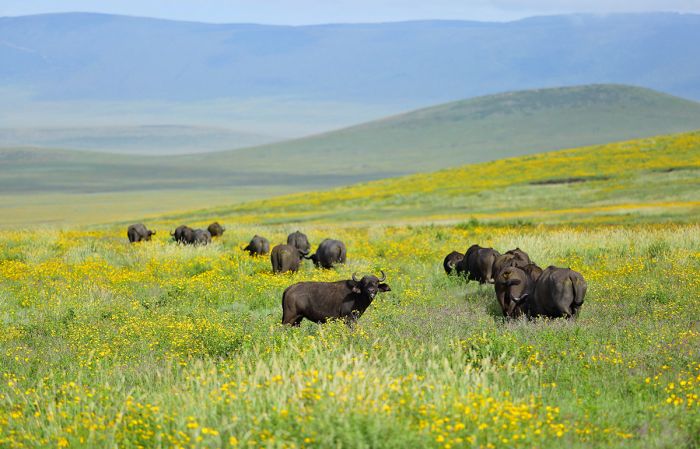
Buffalo grazing in the Ngorongoro Highlands.
About the NGORONGORO CRATER
The Ngorongoro Crater was formed when an enormous volcano on the western portion of Africa's Great Rift Valley erupted and collapsed upon itself some 2.5 million years ago. The violent explosion left a 2 000-foot (610-meter) deep, 12-mile (19-km) diameter crater. The crater covers an area of 108 square miles (280 sq kms), which makes it the world's largest intact and un-flooded caldera. The height of the original volcano is estimated to have been as high as 19 000 feet (5 800 meters).
Today the Ngorongoro Crater is a haven for wildlife and home to between 25 and 30 thousand large mammals, including Africa's highest density of predators. Wildlife in the Crater includes all of Africa's Big Five (lion, leopard, elephant, buffalo, rhino), providing incredible game viewing for its daily visitors. Accommodation is not allowed within the crater, so game drives descend every morning for day-long safaris in the crater and ascend to their camps, many of which are located along the crater rim, at dusk.
The steep and busy "descent road" is usually bumper-to-bumper when the morning game drives depart down into the crater at dawn. Thick mist floats through the highland forest along the rim and upper crater wall, creating an ethereal atmosphere, with birds singing and eager tourists awaiting their first exploration into the crater. The misty forest is mesmerizing in the early morning, with ancient trees, epiphytes, ferns, orchids and tree moss.
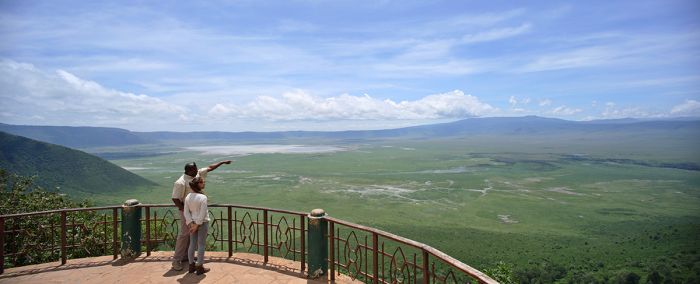
Lookout spot on the rim of Ngorongoro Crater.
The main feature on the crater floor is Lake Magadi, a shallow, soda lake which size is dependent upon recent rainfall. The lake sometimes supports good numbers of flamingos, especially during the dry season.
Wildlife in the crater is diverse and includes all of Africa's Big Five (lion, leopard, buffalo, elephant, rhino). Four of the five are a virtual guarantee on a day-long safari, with leopard being the toughest to find. Black rhinos number around twenty individuals. Lion numbers vary between 50 and 80, while the most abundant predator in the crater is the spotted hyena, which number between three and four hundred. Both golden and black-backed jackal are present in good numbers.
The lovely Lerai Forest on the southern side of Lake Magadi consists almost entirely of yellow fever tree Acacias. The forest is home to bushbuck, waterbuck, and eland. There are also several hippo pools in the crater.
Open grassland covers much of the crater floor, offering ideal habitat for grazing herbivores. Wildebeest and zebra are very common, as well as smaller numbers of buffalo, Thomson's gazelle, Grant's gazelle, hartebeest, mountain reedbuck, warthog, and topi. Elephants range throughout the crater and even climb in and out entirely. Some of the country's biggest and oldest bull elephants are full-time residents. Two species absent from the crater itself are giraffe and impala, although the occasional giraffe has been known to visit the crater, but they never stay long.
Birding in the crater is very good, with flamingos often found on Lake Magadi, as well as abundant water birds in the swamp areas. The kori bustard is commonly seen, as are ostrich and several species of vulture. Over 280 species of bird have been recorded in the crater.
Strict adherence to the crater's game drive rules are enforced and there is no off-road driving. Visitors must stay in their vehicles except at designated picnic spots.
ABOUT OLMOTI & EMPAKAAI CRATERS
Besides the Ngorongoro Crater, the NCA protects two other beautiful, albeit smaller craters: Olmoti and Empakaai. Neither can match the Ngorongoro Crater for wildlife, but both offer spectacular walking safaris into and around the craters, with almost no tourists.
Both craters are easily reached from camps in the region on a day trip. The local Maasai people have some small settlements around these craters.
The 1770-foot (540-meter) deep, 38-mile (61-km) wide Empakaai Crater is dominated by a 200-foot (60-meter) deep soda lake, which covers almost half of the crater floor. The elevation at the crater rim is 10 564 feet (3 220 meters) and at the crater floor 8 793 feet (2 680 meters).
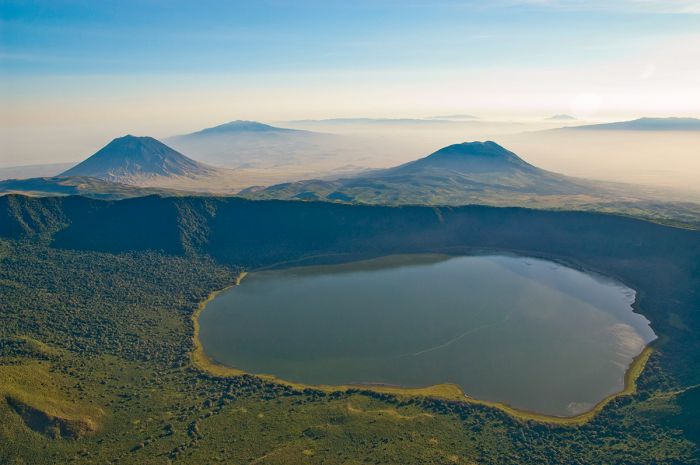
View looking down into Empakaai Crater.
Empakaai crater is incredibly beautiful, with steep, forested walls. The only way to reach the crater floor and the lake is on foot. Thousands of flamingos frequent Lake Empakaai, as well as a variety of other waterfowl. Leopards are present, although seldom seen, but elephants may be seen. Other mammals include buffalo, bushbuck, and blue monkey, which are most often seen along the crater's rim. Bird life is diverse and abundant.
The shallow Olmoti Crater is dominated by grasslands and supports good populations of grazers, including Bohor reedbuck and buffalo. The crater is also used for grazing by local Maasai and their cattle. The seasonal Munge River and waterfall flows out of the crater and winds its way into the Ngorongoro Crater.
The elevation at the crater rim is 9 974 feet (3 040 meters) and at the crater floor 9 186 feet (2 800 meters).
ROOMS INCLUDES & EXCLUDES CHILDREN FACILITIES ACTIVITIES
Accommodation
8 guest accommodations in total comprising:
- 7 dome-shaped suites, 4 of which can be set up with a double or twin beds, and 3 of which can be a triple or quadruple, with up to two twin beds in a loft space to accommodate children under the age of 16 years. One of the suites is the 'honeymoon suite', which uniquely includes an outdoor hot-tub bath.
- 1 double / family suite, consisting of two dome-shaped bedrooms, one with a double bed (convertible to twins) and one with two single beds. The bedrooms each have their own en-suite facilities. A semi-enclosed passageway connects the two bedrooms.
The unique domed suites are constructed using wood, canvas, and perspex atop elevated hard-wood decking. Heavy-duty wooden beams are used to support the elevated suites and access is by a short, outdoor staircase.
The suites include plumbed en-suite facilities with a double-basin vanity, indoor side-by-side showers, and flush toilet. The suites are accessed via footpaths on the ground leading to the main lodge area.
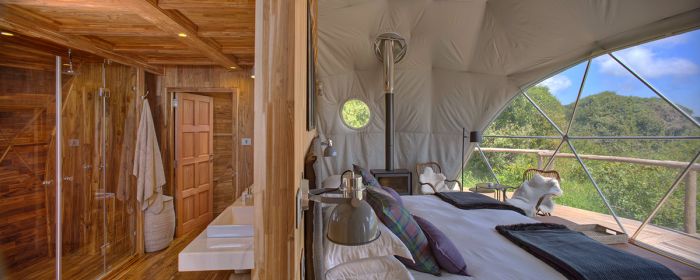
Guest suite at The Highlands Ngorongoro.
The main lodge area and guest suites are set within a lush, montane forest along the northern slopes of the extinct Olmoti volcano. The unique design of the suites was inspired by the similar shape of a traditional Maasai boma.
Each dome-shaped guest suite has a small, indoor sitting area and an outdoor balcony encircling about 40% of the suite and offering views over the forest. A wood-burning fireplace ensures a cozy night in the chilly montane air.
Other items and features in the guest suites include:
- Clothes storage wardrobe.
- Safe.
- Hairdryer.
- 24-hour power (provided using a combination of solar and generator) for lighting and charging electronics.
- WiFi available in the guest suites and main guest areas.
- Mobile phone signal available, but limited.
The Highlands can accommodate a maximum of 24 guests in total: 2 persons in each of the 7 standard suites, up to six additional children in the three suites that have a loft, and 4 persons in the family suite.
Includes & Excludes
Includes:
- All meals and house drinks, including wines, local brand spirits and beers, teas, and coffees.
- Safari experiences (twice-daily or full-day game drives, forest walks, Olmoti and Empakaai Crater hikes, and birding) accompanied by an experienced guide.
- Sundowner drinks and snacks.
- Laundry services are provided on a daily basis (weather permitting, items will be returned on the same day). Laundry is dried by the sun and on most days any laundry placed out in the morning will be returned by the evening.
- Wi-Fi access (throughout the entire camp).
- Seronera Airstrip transfers.
- Tourism Levy & VAT.
Excludes:
- Champagne, cognacs, fine wines, premium brand spirits, and cigars.
- Cultural community visits.
- Spa treatments.
- Purchases from the Gift Shop.
- Any applicable wildlife fee, park fee, reserve fee, concession fee, other land-use fee.
Single Supplement
A single supplement may apply for any room booked by a single traveler; please ask us for pricing.
Children
Children aged 5 years and older are accommodated at The Highlands:
- 1 family suite and 3 standard suites available as a triple.
- Ask us about reduced rates for children sharing with adults or children 12-17 in their own suite.
- The minimum age for children on bush walks is 12 years and at the discretion of the guide.
- Children's menu available.
- Children under 5 years are allowed only if the camp is booked exclusively.
Game drives with children:
- During high and peak seasons, families (less than 5 persons) with children aged 0-12 years must pre-book a private vehicle.
- During low and peak seasons, families (less than 5 persons) with children aged 0-12 years will receive a private vehicle FOC subject to availability. Vehicle must be pre-booked.
- Year-round, families with children aged 0-12 years will receive a private vehicle FOC for every 5 persons in the family. This is subject to vehicle availability and must be booked in advance.
Facilities
The main lodge area and guest suites are set within a lush, montane forest on the northern rim of the extinct Olmoti volcano. The uniquely-shaped domed design of the lodge structures pays homage to the similar shape of a traditional Maasai boma.
The main lodge area consists of three wood and canvas structures comprising a dining space, two lounge areas, and an outdoor viewing deck. A short walk leads to the Highlands Spa, which incorporates a barrel-shaped sauna, a massage room, and a changing room.
Main guest area facilities include:
- The main guest space includes a dining area, lounge, bar, and outdoor viewing deck.
- The viewing deck is also used for dining.
- Dining is typically communal, but private dining is available on request.
- Spa and sauna wellness centre.
- Gift Shop.
- Complimentary Wi-Fi access.
- Mineral water is provided in the main camp areas and in the guest suites.
- The camp is 100% powered by solar energy, but there is a backup generator in case of extended cloud cover during the rainy season.
Activities
Activities included in the rate:
- Morning and afternoon/evening game drives in semi-open 4x4 vehicles.
- Guided forest walks. Children must generally be 12 years of age (or given clearance at the discretion of the guide).
- Guided climb to the rim of Olmoti Crater. The round-trip hike takes 1-2 hours and offers exceptional birding, beautiful scenery, and possible wildlife sightings.
- Guided descent into Empakaai Crater. The drive to the crater takes 75 minutes and the descent takes 30-45 minutes. Offered as a hall-day activity with a picnic lunch and can be combined with the Olmoti climb or a cultural visit to make it a full-day activity. Children must generally be 12 years of age (or given clearance at the discretion of the guide).
- Full-day game drive into the Ngorongoro Crater with a picnic lunch enjoyed in the crater.
- Sundowners.
- Birding.
- Child-friendly activities.
- All game drive vehicles fitted with inverters for battery charging on game drives.
Optional activities at additional cost:
- Private activities are on offer (subject to vehicle availability, which needs to be booked in advance).
- Spa treatments.
- Guided visit to a local Maasai community.
Example of a typical day:
- Early morning wake-up call. Morning wake-up and activity times vary according to the seasons, activities on offer, and wildlife sightings.
- Light breakfast before departing on the morning activity or food packed for an earlier departure.
- Return to the lodge for a meal and rest period (full-day outings mean lunch is packed).
- Meet for afternoon tea and snacks (savory and sweet choices) before departing on the activity.
- Return to camp - freshen up or meet for drinks, followed by dinner.
- Enjoy a nightcap and/or discussion at the bar or around the campfire before retiring.
Great Good Fair Poor
- Jan
- Feb
- Mar
- Apr
- May
- Jun
- Jul
- Aug
- Sep
- Oct
- Nov
- Dec
GENERAL TIPS
The Ngorongoro Crater offers excellent wildlife viewing all year, as its unique ecosystem means that most of the wildlife stays in the crater throughout their lives, so the animals are in effect living in an enclosed environment.
Similar to the Serengeti region just to the west, it is advised to avoid the Ngorongoro region over March and April, when heavy rains typically occur. June to mid-October is excellent for general game viewing in the Crater in terms of the wildlife and the weather.
The Highlands is open year-round.
RAINS
The rainy season in northern Tanzania is from November thru mid-May, with two distinct rain seasons. The "Short Rains" (locally called the "mvuli") fall from mid-November to mid-December and are generally lighter and less impactful to safari activities. The "Long Rains" (locally called the "masika") occur between March and May, brining afternoon showers on a near daily basis.
Short Rains
The short rains occur for about one month sometime during November and December (the exact time varied somewhat year to year). This period is called the 'short' rains because the duration of an individual rain event is short and it is rare to have an all-day rain event. Most rain falls as an afternoon shower, while mornings are typically overcast or clear.
Long Rains
The long rains occur between March and May, with April being the wettest month of the year. During this time, rain should be expected almost every day and the showers can last for hours at a time, although all-day rain is not typical. The roads into and out of the Ngorongoro Crater can be quite difficult during the long rains, which can mean longer times getting in and out. Cloudy skies are typical and temperatures can be chilly at times.
The period between the short and long rains (January and February) also receives rainfall, but many days are clear and the amount and duration of the rain events is unpredictable, with some afternoon showers and the odd long and heavy shower.
TEMPERATURES
The temperatures in the Ngorongoro do not experience wide fluctuations throughout the year, as the region lies between one and three degrees south of the equator. In general, daytime temperatures are comfortably warm and overnights and early mornings are chilly. Bring a fleece and rain jacket regardless of the timing of your visit.
Ngorongoro's climate is generally mild, but temperatures in the Ngorongoro Highlands, including the camps and lodges at the Ngorongoro Crater, are heavily influenced by their higher elevations. Temperatures around the crater experience chilly to cold nights, so be prepared with appropriate attire. The Ngorongoro Crater rim (7 500 feet / 2 286 meters) and the Crater floor (5 500 feet / 1 676 meters) are at much higher elevations than the vast plains of the Ngorongoro Conservation Area to the west.
Conditions inside the Ngorongoro Crater are pleasant during the day when game drives are allowed, with temperatures averaging 68-73°F (20-23°C). Accommodations for the crater are up on the rim or further outside the caldera, where nighttime temperatures drop significantly and can approach freezing in the dry season (Jun-Oct) and average 42°F (5°C) during the rainy season (Nov-May).
THE GREAT MIGRATION
The annual movement of wildebeest and zebras across the Serengeti-Masai Mara ecosystem is one of the greatest spectacles in the natural world. These large herds move in a circular track across southern Kenya and northern Tanzania, taking a full year to complete their cycle. The migration moves across both the Greater Masai Mara (in Kenya) and the Greater Serengeti (in Tanzania) in a fairly consistent pattern and timeframe. The animals move to take advantage of fresh grasses on which to graze.
The migrating herds of roughly 1.5 million blue wildebeests and several hundred thousand plains zebras spend about nine months of the year moving through Tanzania's Greater Serengeti (which includes the Ngorongoro region) and the other three months in Kenya's Greater Masai Mara.
The migrating herds are in Tanzania's Greater Serengeti from sometime in October until around late-July (note that the timing is never precise and varies somewhat year to year). Note that the Greater Serengeti is vast, and it is important to note where in the region the herds are located during this nine-month timeframe.
The large herds of animals in the Great Migration usually cross into the Serengeti from Kenya's Masai Mara sometime around early October and move north back into Kenya around mid- to late-July.
Most of the migration stays west of the Ngorongoro Highlands, where thousands of animals move through the western portion of the Ngorongoro Conservation Area, especially around Lake Ndutu, where they spend the months of December thru April. Wildebeest calving occurs in the southern Serengeti and Ndutu area in February.
There are numerous safari camps that are set up on a seasonal basis to best see the migration throughout the Greater Serengeti, including the Lake Ndutu Area.




